

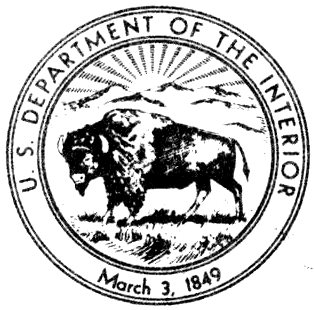
UNITED STATES DEPARTMENT OF THE INTERIOR
Fred A. Seaton, Secretary
NATIONAL PARK SERVICE
Conrad L. Wirth, Director
For sale by the Superintendent of Documents,
U. S. Government Printing Office
Washington 25, D. C. Price 25 cents
By John M. Good, Theodore E. White and Gilbert F. Stucker
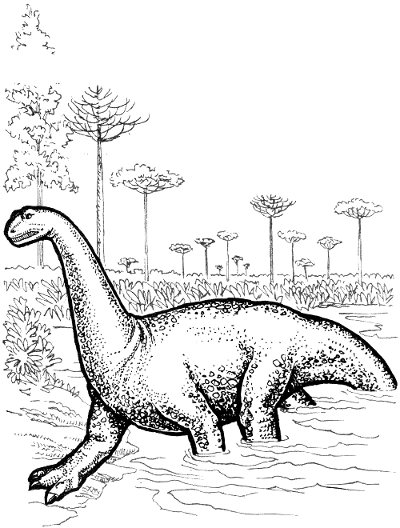
NATIONAL PARK SERVICE · Washington, D. C., 1958
The National Park System, of which Dinosaur National Monument is a unit, is dedicated to conserving the scenic, scientific, and historic heritage of the United States for the benefit and enjoyment of its people.
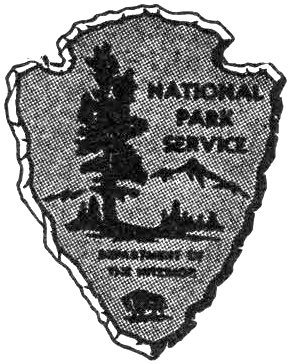
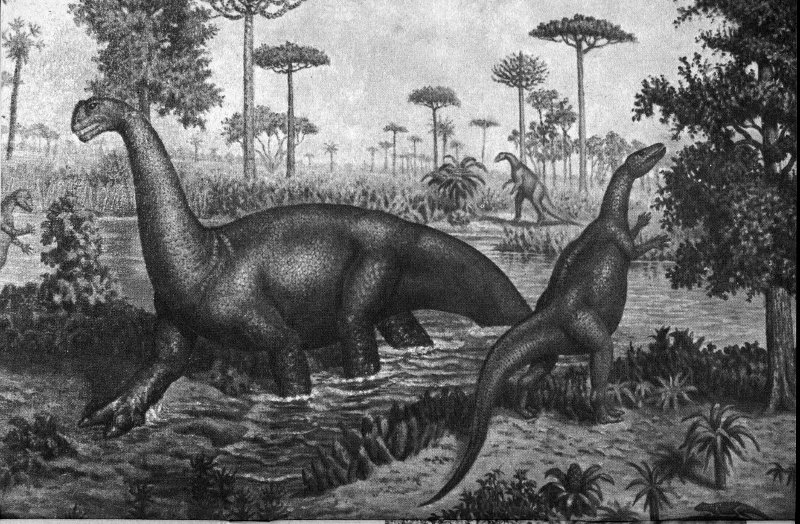
JURASSIC LANDSCAPE SHOWING ANIMALS AND PLANTS THAT LIVED HERE DURING MORRISON TIME. (FROM A PAINTING BY ERNEST UNTERMAN.)
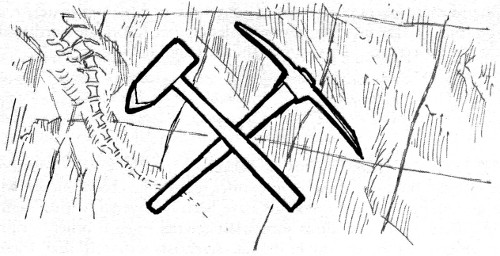
As you approach Dinosaur National Monument from Jensen, Utah, you see the mass of Split Mountain and the deep, short canyons that scar its south slope near the Green River’s gorge. As you cross the National Monument boundary the grand view is lost and you begin to notice details. The masses of gray shale that seem to be carelessly piled against the tilted sandstone layers are bare of vegetation. The ground between the hills and the Green River is covered with sagebrush and greasewood, while along the river itself are a few large cottonwood trees and many bushes. A sharp turn brings a change of scene as your car enters a portal in the wall you have been following. The pronounced tilt of the rocks becomes more obvious.
A final steep climb and the visitor center is at hand. This building encloses a significant part of the Dinosaur Quarry, perhaps the greatest deposit of fossil dinosaur bones known today. From this quarry have come many of the dinosaur skeletons that are seen today in our great museums. After parking, a short walk to the overlook on the southeast reveals a splendid view of Split Mountain. Between that broad arch of eroded sandstone and the quarry lie steeply tilted sedimentary rocks of various compositions and hues. Buff and gray sandstones that weather into soft shapes are separated by reddish-brown shale. Directly to the east is a section of varicolored shale whose pastel pinks, reds, greens, grays, and whites justify the name of “rainbow beds” that was given them by geologists. In the upper part of this section are hard sandstone and limestone layers that resist the erosive action of wind and water. They stand higher than the softer shales and form hogbacks that rim Split Mountain.
One of these layers can be traced across the ravine immediately east of the parking area into the sandstone ledge that forms the north wall of the visitor center. This is the famous Dinosaur Ledge.
The Dinosaur Ledge is famous because here the world’s greatest store of fossil bones of these long extinct reptiles has been uncovered. Two groups, or orders, of dinosaurs have been discovered, with a number of different types or kinds somewhat related to each other within these orders. From the fossil bones, scientists can tell that these creatures varied greatly in size and habits of living.
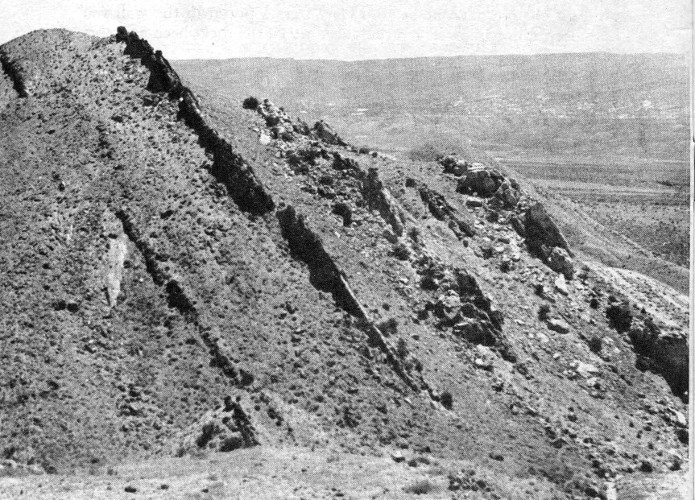
TILTED ROCK STRATA NEAR THE DINOSAUR QUARRY.
Some were the size of chickens, others as big as horses, and others of such gigantic size that no land animal alive today can compare with them. Some were flesh-eaters as indicated by the size and shape of their teeth and their long sharp claws. Others were plant-eaters and again it is the structure of their teeth and feet that tell us this. The 3 flesh-eaters were two-footed and walked on their hind legs, balancing themselves with heavy long tails. Their short front legs were used as clawed-arms for tearing at the flesh of other dinosaurs. Many plant-eaters, on the contrary, were large, heavy, four-footed beasts, often with long necks and tails. Many of the dinosaurs were land dwellers, and many others lived in the great marshes and swamps of the long Mesozoic (middle life) Era of the earth’s history.
Though the subclass of reptiles we call dinosaurs lived all through the Mesozoic Era, those whose fossil bones have been uncovered in this Dinosaur Quarry are embedded in a stratum of rock called the Morrison formation. This rock stratum dates from the Jurassic Period in the middle of the Mesozoic Era.
Today, most of us would recognize a fossil bone for what it is, but in the 1790’s things were different. Isolated legbones, vertebrae, and teeth of huge reptiles had been dug out of certain sedimentary rocks of Europe and North America but their scientific importance was little understood.
These specimens were found by people in all walks of life and it was natural that their curiosity was greatly aroused. The finders took the specimens to someone nearby whom they considered more competent to tell them something about these strange bones and teeth. In nearly all cases these “experts” were doctors of medicine. They studied the fossil specimens and reported on them at regular meetings of the learned societies of which they were members. It was customary to put the fossils in the collections of these societies where they could be studied by other members. In North America most reports of these early discoveries are found in the Proceedings of the American Philosophical Society in Philadelphia, Pa.
By 1842 accumulated knowledge of these large reptiles was sufficient to show that they were distinct from any group then known. This was first recognized by Sir Richard Owen of the British Museum. It was he who named the group Dinosauria. The name is made up of two Greek words: deinos (terrible) plus sauras (lizard).
As knowledge of these unusual reptiles increased through the discovery of additional types and more complete and better preserved specimens, it became evident that dinosaurs were neither a single group of reptiles nor were all of them large. Actually the dinosaurs show as much diversity in size, body form, and habits as any group of reptiles. The smallest dinosaur walked on its 2 hind legs like a chicken 4 and was about the same size. The largest walked on all 4 legs, was about 80 feet long, and weighed 30 to 40 tons. As examples of variety in body form there are the two-footed, flesh-eating Antrodemus, the armored Stegosaurus, the turtle-like Ankylosaurus, the horned Triceratops, the huge Apatosaurus, the two-footed vegetarian Camptosaurus, and the great variety of head forms in the aquatic hadrosaurs. Although there were two distinct groups, we still retain the term “dinosaur” as a convenient name for all of them but qualify it by saying, flesh-eating dinosaur, plant-eating dinosaur, armored dinosaur, etc., to indicate the particular type we are talking about. Perhaps you are wondering how all these ancient creatures are related to reptiles in general. Where do they fit in the classification system devised to bring order to this mass of knowledge?
It seems there are several orders of reptiles similar to and closely related to the dinosaurs. Remains of these reptiles are found in the sedimentary rocks which contain the earliest known dinosaurs. A number of them resembled the dinosaurs but do not quite meet the requirements as far as details of the skeleton are concerned. In the scheme of classification these orders of reptiles are grouped together into the subclass Archosauria. This subclass includes the dinosaurs, crocodiles, and the flying reptiles. The lizards, snakes, turtles, and the tuatera of New Zealand belong to other subclasses of reptiles which have been distinct from that of the dinosaurs as far back in geologic time as we can trace them. The kinship between the dinosaurs and the small lizards living in the monument today lies only in that both are reptiles. The only living relatives of the dinosaurs are the alligator and the crocodile.
The dinosaurs were so numerous, and so dominated the whole of the Mesozoic Era, that this period of earth history is frequently referred to as the Age of Reptiles.
The Mesozoic Era began some 200 million years ago and ended some 60 million years ago. Although many other animals lived during that era, the dinosaurs were the dominant forms of animal life on land. The 140 million years of the Mesozoic are divided into geologic periods named Triassic (the oldest), Jurassic, and Cretaceous (the most recent). Continental deposits representing each of these periods have been found in all parts of the world and on all continents. Dinosaur bones have been found in these deposits—even in such far-away places as Australia and the southern tip of South America. 5 Only Jurassic dinosaurs have been found at Dinosaur National Monument.
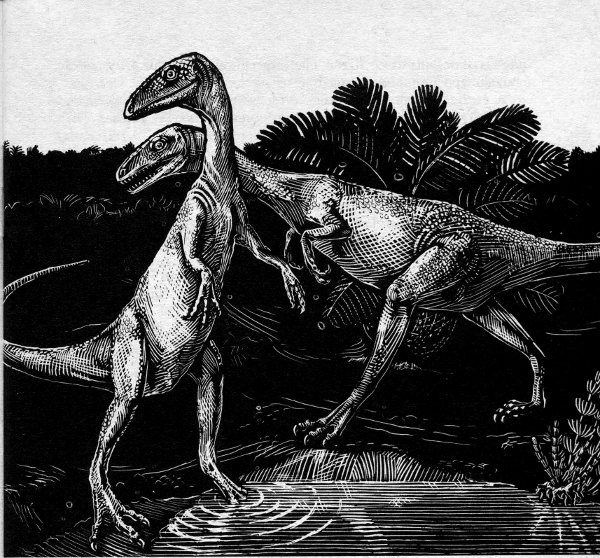
Coelophysis—SMALL TRIASSIC DINOSAURS, FORERUNNERS OF THE HUGE DINOSAURS OF JURASSIC PERIOD. (DRAWN BY MARGARET M. COLBERT. COURTESY, AMERICAN MUSEUM OF NATURAL HISTORY.)
The oldest known dinosaurs are found in rocks of the Triassic Period. The smaller of these were chicken-size and the largest were about as big as kangaroos. All of these Triassic dinosaurs were two-footed. They can be divided into flesh-eaters and plant-eaters, although none are believed to have been particularly specialized in their food habits. In general the flesh-eaters were small, agile, and had sharp teeth for seizing and overpowering active prey. The plant-eaters were larger with rather long front legs and small blunt teeth suited only to cropping vegetation. These plant-eaters are believed to be 6 the Triassic ancestors of the giant marsh-dwelling dinosaurs of the Jurassic and Cretaceous Periods.
A greater variety of dinosaurs lived during the Jurassic Period than in the Triassic. Both two- and four-footed types were present. The flesh-eaters remained two-footed but increased in size. Antrodemus, perhaps the best known, was much bigger than a kangaroo. The larger plant-eaters weighed from 30 to 40 tons and all were four-footed. The largest land animals, they lived on dry land and in the swamps that formed an important part of the Jurassic landscape. The first of the armored plant-eating dinosaurs, Stegosaurus, inhabited the dry plains. There were also some smaller, kangaroo-size plant-eaters that were two-footed.
A wide variety of dinosaur fossils has been found in the rocks of the Cretaceous Period, the last of the Mesozoic Era. The huge swamp dwellers still thrived. The flesh-eaters had evolved much larger types and included 40-foot Tyrannosaurus, the largest that ever lived. All the flesh-eaters walked on their hind legs as did their predecessors of the Jurassic and Triassic Periods.
New and interesting dinosaurs were present among the flesh-eaters. Horned forms, somewhat similar to the rhinoceros but much larger, were common. Also common were the turtle-like ankylosaurs. Perhaps the oddest and most interesting dinosaurs of the Cretaceous were the two-footed hadrosaurs. These excellent swimmers had weird head shapes with complicated skull passages and openings. They were a very successful group and at least 15 different kinds are known from the Cretaceous rocks of North America.
Ideas about the external appearances of dinosaurs have been developed after many years of work and study. They are a combination of the ideas of several people who had studied different specimens of a single species. Let us review briefly the materials and work necessary to arrive at a reasonably accurate picture of the body form and external appearance of these strange reptiles.
The first requirement for arriving at a good idea of the build and physical attitude of an animal is a nearly entire skeleton. We cannot have too much of the animal’s skeleton missing or we may make a serious error. But if the left hind leg is missing and we have the right, we are not seriously handicapped. However, if both hind legs are missing we must restore them according to a similar animal whose hind legs are known.
After the nearly entire skeleton has been found it must be collected with great care. This is a rather involved process and, for some of the large dinosaurs, 2 or 3 months work may be required. The specimen 7 is first uncovered and the fossil bone is treated with a preservative such as gum arabic, shellac, or one of the plastics. An accurate diagram of the specimen as it lies in the rock is made on cross-ruled paper. A trench 2 or 3 feet wide is then dug around the specimen. The depth of the trench is determined by the width of the specimen and the nature of the rock.
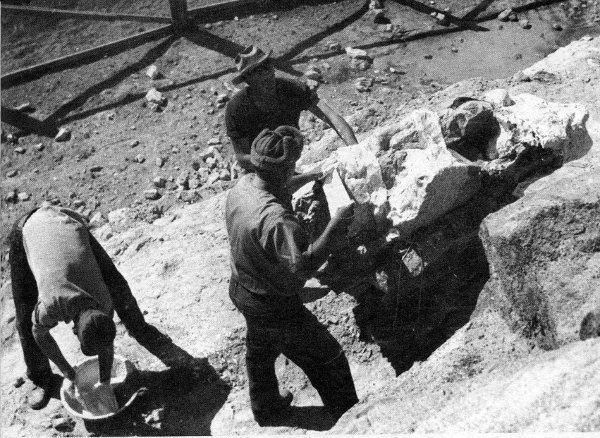
PUTTING PLASTER CAST ON A FOSSIL BEFORE REMOVING IT FROM THE QUARRY.
If the specimen is too large to take out in one piece, as most dinosaurs are, it is divided into sections which are numbered serially as they are taken out. Each section is bandaged in strips of burlap dipped in plaster of Paris. After the plaster has set, the section is turned over and the bottom is sealed with burlap and plaster. The section is labeled with the appropriate number and the section and number are shown on the diagram.
When all of the sections have been bandaged and numbered they are packed in strong wooden boxes and shipped to the laboratory.
The work in the laboratory is more involved than that in the field, and extreme care must be exercised to be sure that the bones will be undamaged. In most cases the bones have been broken by natural causes as they lay in the rock before discovery. All the pieces of each bone must be thoroughly cleaned and securely cemented together. 8 This is a very time-consuming task and for a large dinosaur like Apatosaurus it requires 3 men 4 or 5 years to complete the task.
After all of the bones are cleaned and cemented together the vertebral column is laid out in its proper sequence on a sand table. Special care is exercised to be sure that the vertebrae fit correctly with each other. In this way the correct curvature of the vertebral column is determined. The proper relationships of the hip bones and ribs to the vertebrae, the shoulder blade to the ribs, and elements of the limb bones to each other are determined in the same manner. All of this work is necessary to correctly fashion the steel framework which will support the skeleton when it is placed on exhibition. The results of this careful work must be the framework of an animal which could, if living, easily go through the normal activities of life such as securing food and escaping enemies.
Now that the framework of an animal has been set up so that it could move about if it had muscles, skin, and life, how do we know how large the muscles were and where they were placed? It is necessary to have a thorough knowledge of the muscles of a recent animal similar to the one we are restoring so that we will know what we are looking for in the fossil. The areas at which muscles are attached to bones are called muscle scars and are identified by their rough surfaces. Often the necessary information can be obtained from publications which usually represent the work done by graduate students for advanced degrees. At other times we must make our own investigation. Thus if we know what muscle we are looking for and the size and shape of its muscle scar, we can determine whether the muscle is a spindle-shaped mass or a broad sheet.
After we have determined the size and position of the muscles which operate the limbs, head, and neck, we have a reasonably accurate idea of the external form of the animal, but we still know nothing of the nature of the skin which covered the body. Since dinosaurs were reptiles, we are obliged to assume that they were covered with a scaly skin in order to preserve the body moisture. None of the modern reptiles possess sweat glands in the skin. If they did not possess a waterproof covering of scales they would die in a few hours as a result of the loss of body moisture by evaporation through the skin. It is possible that some of the marsh dwellers like Apatosaurus had naked skin which was, as in the elephant, nearly an inch thick. The elephant does not possess sweat glands but the outer half of its skin is composed entirely of dead cells which form a covering as waterproof as the scales of today’s reptiles.
There have been only a few lucky finds of mummified dinosaurs which show the impressions of the scales. We know that all lizards do not possess the same type of scales, and therefore, by analogy, we cannot assume that the dinosaurs did. Eventually, we will probably 9 find that the dinosaurs exhibited as great a variety of scale-types as do today’s lizards. As yet we have found nothing in the fossil record which indicates the color of the dinosaurs. Again, we can only assume that they exhibited as great a variety of colors as do our lizards. So also, we assume their body functions were somewhat similar to the reptiles and other related animals we know today.
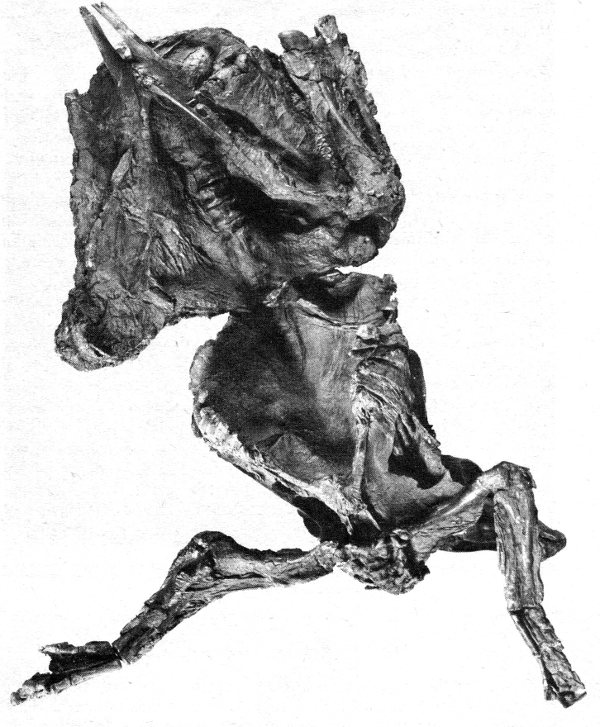
DINOSAUR FOSSIL WITH SKIN AND LIGAMENTS PRESERVED. (NOT FROM DINOSAUR QUARRY. COURTESY, AMERICAN MUSEUM OF NATURAL HISTORY.)
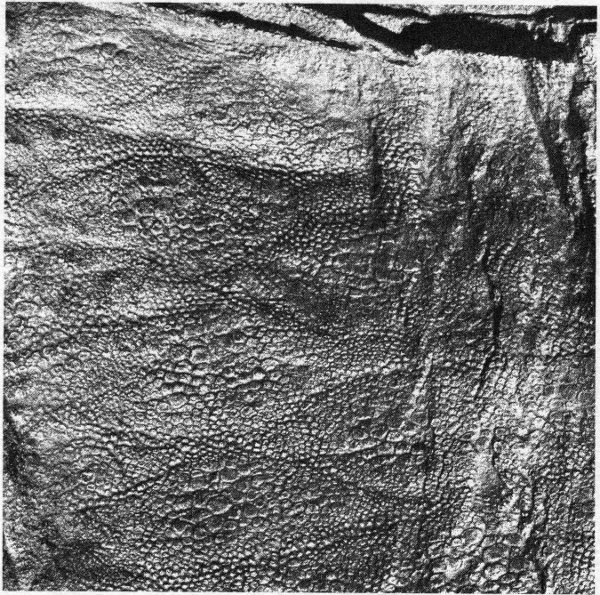
RARE FOSSIL OF DINOSAUR SKIN. (COURTESY, AMERICAN MUSEUM OF NATURAL HISTORY.)
We know the body temperatures of reptiles vary with that of the air or water in which they live, as they have no means of internal temperature control. They are very sluggish when their body temperatures are low and become more active as these temperatures rise, but only to a certain point. If the body temperatures of reptiles become too high, they die in a few minutes.
A group of physiologists from Columbia University spent nearly 2 months in southern Florida experimenting on reptiles. They determined the rate of rise of body temperatures of large lizards and alligators of all sizes during exposure to the midday sun. As was expected, the smaller the reptile the more rapid the rise in body temperature. Dinosaurs were reptiles so we can make two assumptions: That their physiology was very similar to that of living reptiles; 11 and that the rate of rise of their body temperatures from exposure to the sun would follow the principles found for living reptiles.
By applying these principles to the dinosaurs, this group of scientists calculated that if the great bulk of an Apatosaurus were exposed to the direct rays of the sun at an air temperature of 110° F. for 36 to 40 hours, its body temperature would rise only 1° F. Therefore, if these calculations are correct, it is probable that the very size of the huge dinosaurs operated to maintain a fairly constant body temperature. Consequently, daily and seasonal temperature changes probably did not affect the activities of the large dinosaurs. However, the activities of the small ones may have been affected by the daily range in temperature.
For many years rounded stones with a very high polish have been found in the sedimentary rocks which contain bones of extinct reptiles. The polish on these stones is very much higher than could have been applied by the action of water or wind. Some look as though they had been polished by a jeweler. Since we cannot attribute this very high polish to wind or water action, we must seek another agent.
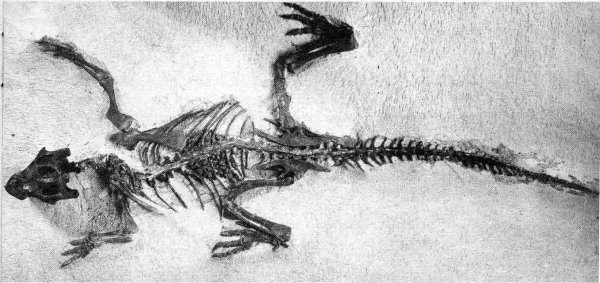
Protiguanodon. NOTE GIZZARD STONES INSIDE RIB BASKET. (COURTESY, AMERICAN MUSEUM OF NATURAL HISTORY.)
Just as chickens swallow fine gravel for their gizzards to aid digestion, so it is thought that some large dinosaurs swallowed stones for the same purpose. There is some evidence to support this idea. Several 12 specimens of a group of swimming reptiles, called plesiosaurs, which swarmed the Jurassic and Cretaceous seas, have been found with highly polished stones inside the rib basket. Also a mass of highly polished stones was found similarly associated with one dinosaur, Protiguanodon, in the Lower Cretaceous rocks of Mongolia.
On the other hand, no highly polished stones have been found associated with the specimens in the Dinosaur Quarry or anywhere in the quarry. A search of the many publications on dinosaurs has not turned up any mention of highly polished stones being associated with any of the many specimens found in North America. Thus the evidence which we have does not permit us to say that the dinosaurs found in the quarry did or did not possess gizzard stones.
The geologists who attempt to reconstruct the geography and climate of the Jurassic Period first gather all possible facts and try to fit them together to form a logical pattern. The results are then examined for weak points and an attempt is made to find field evidence throwing light on these weak points. The final result represents the sum of our knowledge at the time but is subject to change as new facts are obtained. Thus the following outline represents present thinking that may be changed somewhat by future studies.
The land for miles around the Dinosaur Quarry was a low-lying desert in early Jurassic time. The mountains you see now had not yet been formed, and the whole desert area lay close to sea level. Great restless sand dunes drifted across this level land to form a blanket 700 feet thick. As the earth’s crust sank, these dunes were covered by a long arm of an arctic sea that extended southward along the present trend of the Rocky Mountains across Canada, Montana, Wyoming, and Utah. Millions of years later, in late Jurassic time, when the Morrison formation was deposited, the area rose again and the stage was set for the dinosaurs.
Imagine if you can, the vast plains extending from Mexico to Canada and from central Utah to the Mississippi River. To the west were high mountains in the Great Basin region of Nevada and western Utah. From these highlands flowed great sluggish streams that carried large amounts of sand and silt. Since the plains were almost flat, swamps and small lakes were probably numerous. The streams may have changed their courses from time to time as they were not confined to deep valleys. When the whole region emerged from the sea the climate became more humid. Volcanoes were active far to the west; the winds carried clouds of ejected dust eastward and deposited 13 them on the plains. Semi-tropical conditions probably existed throughout the United States and in parts of Canada. These deposits are called the Morrison formation.
The warm humid climate provided ideal conditions for plant growth. Great forests of lush vegetation covered the land. Many of these plants have since disappeared, but some of their related species may be found today in the tropics. Most of the plants of our Temperate Zone had not yet evolved. However, there were tall stands of a type of pine, and other evergreens. There were also gingkos and curious tree ferns.
Various herb ferns formed a ground cover as thick and lush as grass on a well-watered prairie. Palmlike ferns resembling today’s cycads were common, while along the river grew horsetail rushes like those living today. Flowering plants of the Recent Epoch of geologic time (in which we are now living) had not yet made their appearance. Thus the hardwood, broadleaf forests of oak, elm, beech, maple, and similar trees were absent. So too were the flowering shrubs familiar to the Temperate Zone. Even the grasses were missing.
However, if you could picnic in this strange plant world you would soon be slapping mosquitos and cursing the ants. For even in such ancient times these insects were present; and so were a great variety of other insects as is known from the more than 1,000 species that have been discovered in Jurassic rocks. Among them were representatives of most modern orders such as grasshoppers, beetles, moths, ants, and flies. Jurassic insects probably looked much like those of today.
Among the most interesting of the strange reptiles were the pterosaurs that dominated the skies. They resembled the modern bats in some ways but their leathery wings were supported on each side by one finger instead of four, and their skins were scaly or bare instead of hairy. Some forms had long tails that were flattened at the tip and helped them balance in flight, but others were tailless. Some pterosaurs were no larger than sparrows while others had wing spans of 3 to 4 feet.
Crocodiles sunned themselves on the banks of sluggish streams and lakes. They probably looked a good deal like those that live in modern swamps and their habits were similar. Many a small dinosaur fell victim to their stealthy attack and disappeared beneath the waters of some ancient stream.
Birds have been found in Upper Jurassic rocks of Germany and may have lived here too. Their fossil remains would probably have been classed as reptiles had not feather imprints been a part of them. About the size of crows, these reptile-like birds had small conical teeth, three-clawed fingers on each wing, and a long tail instead of the fan of feathers seen on modern birds.
Small mammals were also living at the time the Morrison formation 14 was being deposited and their remains have been found in the dinosaur quarry at Como Bluff, Wyo. The largest ones were about the size of a house cat but the majority were much smaller, probably about the size of today’s mice.
We do not know much about the habits of these early mammals but they were probably rather shy and retiring. This would be expected in the world of giants where they lived. Some of them lived in trees and there was one group whose skull characteristics resemble those of the rodents. It is likely that these primitive mammals lived a life similar to that of the rodents millions of years later.
This, then, was the setting, the stage upon which the dinosaurs played their leading roles. Although we have restricted our discussion to Morrison time in northeastern Utah, the same or similar animals lived all over the world. Worldwide humid and mild climates produced a similarity of plant and animal life during most of the Mesozoic Era whose like has not been seen in the last 60 million years. It was a strange world and ruled by strange animals, but it must have been an interesting one.
This is a good time to stop and try to explain that this story, of plants and animals of the past, has a firm foundation in today’s facts—it is not a fantasy.
The methods by which geologists and paleontologists have established the age, climate, and life of Morrison time cannot be described for you here in detail. To attempt such a description would require too much space and would probably seem dull to most readers. Perhaps the best approach is to describe some features and explain how they contribute to our knowledge.
The rocks that were deposited here in Morrison time tell us much of the story. The sandstones were once stream sandbars or perhaps beaches around lakes. The shale, siltstone, and clay were muddy stream or lake bottoms. The discontinuous ledges of conglomerate probably represent gravel bars formed during flood stages or at places where the stream currents were very swift.
Just rocks you may say—but look closely. A piece of sandstone contains grains of sand that differ from each other in size, shape, and composition. Frequently these characteristics point to the source of the sandstone and tell something about the conditions at the time it was deposited. Chunks of black material are examined closely and prove to be charcoal—carbonized remains of plants.
Microscopic examination of clay fragments reveals shards of volcanic glass and ash that speak of active volcanoes. Sometimes these clays bear the carbonized imprints of delicate plants that long ago 15 sank to the bottom of some lake or stream where they were buried and fossilized.
The fossils themselves are most important in reconstructing conditions of the past. We find the shells of fresh-water clams in the sandstones with dinosaur bones. Crocodile bones are also common. We are reasonably sure, then, that these deposits of sand and mud were formed in rivers and lakes when the climate was mild.
We reason by analogy. For example, fossil plants and animals have counterparts or descendants in the world of today. We assume, in the absence of contrary evidence, that the fossil animals lived like their present-day counterparts. Although no birds, mammals, or pterosaurs have been found in this quarry, they were probably living here with the dinosaurs. It is possible, in fact probable, that some modern animals and plants live in different environments than did their Morrison ancestors and relatives but we have no way of knowing which ones they were. We can only take the data available, arrange them as logically as possible, and continue the search for more. Some may scoff at such methods of reasoning yet they do provide good results. What other methods can be used when the world under investigation lies millions of years in the past?
In the rocks of the Morrison formation at the quarry, both orders of dinosaurs are found—Saurischia and Ornithischia. Paleontologists have divided the dinosaurs into these two groups on the basis of important skeletal differences. These differences remain constant for the orders and vary within each order only in small details.
The important structural difference in dinosaurs is found in the pelvis. In all land vertebrates, the pelvis is made up of three pairs of bones called the ilium, pubis, and ischium. The paired ilium is joined to each side of the backbone and projects downward to meet the pubis and ischium at the socket for the head of the thigh bone. The pubis forms the front third and the ischium the rear third of this socket. In the order Saurischia the bones of the pelvis are arranged as in most reptiles and mammals. In the order Ornithischia the pubis extends backward along the ischium as it does in the birds.
Two types of saurischian dinosaurs are found in the quarry. Antrodemus, a flesh-eating type, was about the size of a horse, but was two-footed. It had strong sharp claws on its feet. Its teeth were about 2 inches long, flattened from side to side and with fine serrations on front and back edges. Actually it is not known whether Antrodemus overpowered and killed the large swamp-living dinosaurs, or merely 16 fed on their carcasses after they had died from other causes. However, there has been found in the quarries at Como, Wyo., a partial skeleton of Apatosaurus with grooves on the bones which suggest tooth marks. The spacing of these grooves fit the spacing of the teeth of a specimen of Antrodemus found in the same quarry.
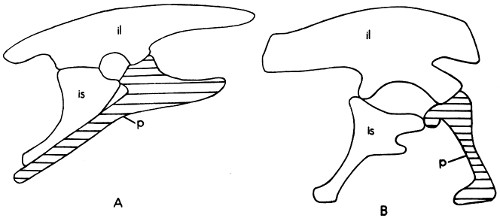
A. ORNITHISCHIAN PELVIS. B. SAURISCHIAN PELVIS.
KEY: IL—ILLIUM; IS—ISCHIUM; P—PUBIS.
The plant-eating dinosaurs of the order Saurischia which are found in the quarry were all four-footed. They had bodies about the size of an elephant or larger. The principal differences between the flesh- and plant-eating dinosaurs were the length of the neck and tail, the details of their skull structure, and other parts of their skeleton.
Apatosaurus is perhaps the most familiar dinosaur to most of us. Its hind legs were much longer than its front ones and gave the animal a high-hipped, stooped appearance. Apatosaurus was about 70 feet long and probably weighed close to 40 tons. Diplodocus was longer (one of them 75½ feet) but was slender and lightly built. Its neck was longer and it had a whiplash tail that looked much like the tail of the modern whiptailed lizard. Diplodocus also had long pencil-like teeth different from those of any other known dinosaur. Barosaurus has an extremely long neck with long individual neck bones. Two members of the genus Camarasaurus are similar to each other except for size; one was small, but the other was as large as Apatosaurus. Camarasaurus had longer front legs than Apatosaurus and was generally better proportioned.
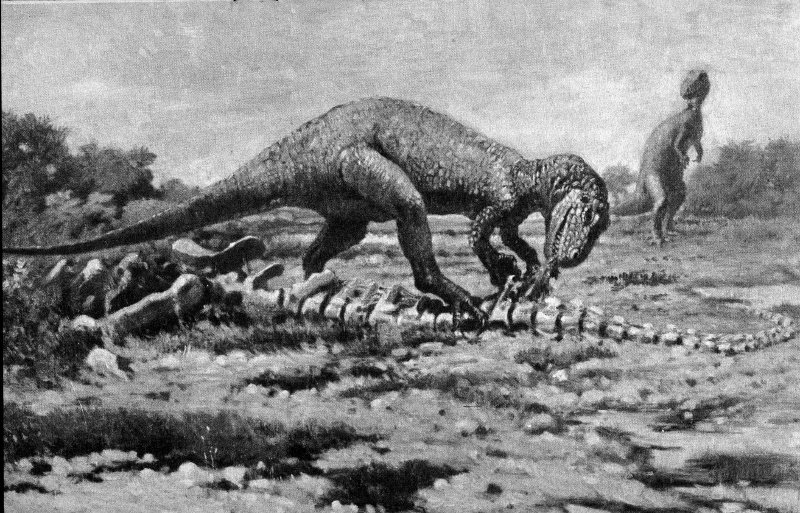
Antrodemus, THE FEROCIOUS CARNIVORE OF MORRISON TIME. (FROM A DRAWING BY CHARLES R. KNIGHT. COURTESY, AMERICAN MUSEUM OF NATURAL HISTORY.)
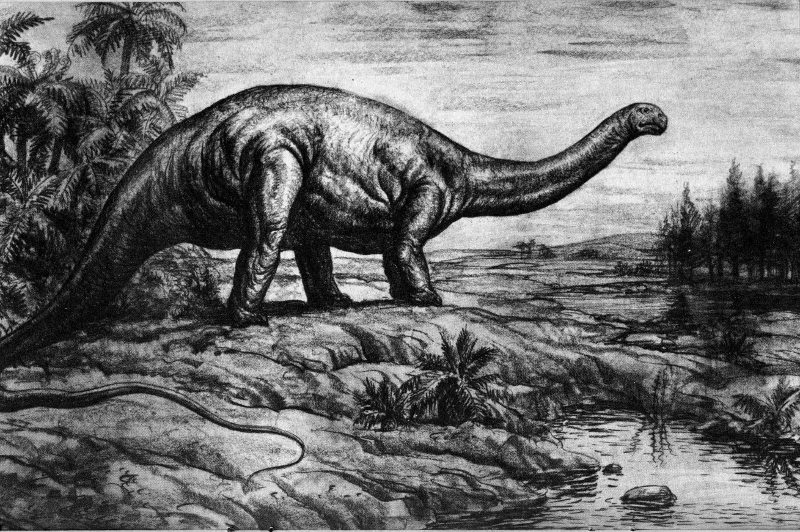
THE GREAT SAURISCHIAN PLANT-EATER Apatosaurus louisae—ABOUT 70 FEET LONG. (FROM A DRAWING BY A. AVINOFF, CARNEGIE MUSEUM.)
Fossils of the saurischian plant-eaters are found much more frequently than those of flesh-eaters and are usually in sedimentary rocks which contain beds of clam shells. For this reason it seems probable that they waded lagoons and streams, feeding on aquatic and bank-side vegetation. The suggestion has been made that the larger dinosaurs could not even walk on dry land because their weight would have crushed the bones of their feet; they needed the buoyancy of water to help support them. However, footprints of a huge dinosaur, much larger than any from the quarry, have been found near Glenrose, Tex. The large footprints were made on a sandy beach of a sea in Lower Cretaceous time. Thus we know that they could walk on dry land if they wanted to.
All of the dinosaurs of the order Ornithischia were plant-eaters, and were of both two- and four-footed types. The two-footed types found in the quarry are Camptosaurus, Dryosaurus, and Laosaurus. These forms had well developed front legs, though much shorter than their hind legs, which suggests that they may have dropped down on “all fours” while feeding or resting. The teeth were small, chisel-shaped, and fitted only for cropping vegetation. The larger specimens of Camptosaurus reached a length of 17 feet but Laosaurus was only 2½ feet long.
Stegosaurus is the only quadruped (four-footed) of this order found in the quarry. It had long hind legs and very short front legs. It reached a length of 18 to 20 feet and was 10 to 11 feet high over the hips. The most characteristic feature of this form was the double row of bony plates down the back and the group of spikes at the end of the tail. The teeth were similar to those of Camptosaurus, but much more numerous.
Only two other groups of reptiles have been found in the quarry at Dinosaur National Monument and their remains are rare. These are the crocodiles and turtles. Two crocodiles are known; the larger one, Goniopholis, was about the size of existing alligators and did not differ in external appearance from present-day crocodiles. The smaller one was less than a foot long and resembled a 2 weeks’ old alligator as much as anything. However, we know from the texture of the surface of the bone that it was not a young animal. The turtle, Glyptops, was about the same size and general appearance as the pond turtles of today.
The partial skeletons of more than 20 individual dinosaurs and the scattered bones of about 300 more have been discovered in the Dinosaur Quarry. Many of the best specimens may be seen today at museums of natural history in the larger cities of the United States and Canada. The quarry is easily the largest and best preserved deposit of Jurassic dinosaurs known today.
How and why did so many dinosaur skeletons accumulate here? How were they preserved? These are among the common questions asked of park rangers and naturalists at Dinosaur. The answer is a combination of circumstances and luck.
Many people get the impression from the mass of bones in the quarry wall that some catastrophe such as a volcanic explosion or a sudden flood killed a whole herd of dinosaurs in this area. True enough this could have happened, but it probably did not. The main reasons for thinking otherwise are the scattered bones and the thickness of the deposit. In other deposits where the animals were thought to have died together, the skeletons were usually complete and often all the bones were in their proper positions, or articulated. In a mass killing the bones would have been deposited on the stream or lake bottom together at the same level, but in this deposit the bones occur throughout a zone of sandstone about 12 feet thick. The mixture of swamp dwellers and dry-land types also seems to indicate that the deposit is a mixture derived from different sources. Rounded fragments of fossil bone have been discovered in the quarry—fragments that attained their pebblelike shape by rolling along the stream bottom.
If the mass of bones was not the result of catastrophe what did happen? The quarry area is a dinosaur graveyard, not a place where they died. A majority of the remains probably floated down an eastward flowing river until they were stranded on a shallow sandbar. Some of them, such as the stegosaurs, may have come from far-away dryland areas to the west. Perhaps they drowned trying to ford a tributary stream or were washed away during floods. Some of the swamp dwellers may have mired down on the very sandbar that became their grave while others may have floated for miles before being stranded.
Even today similar events take place. When floods come in the spring, sheep, cattle, and deer are often trapped by rising waters and frequently drown. Their bloated carcasses float downstream until the flood recedes and leaves them stranded on a bar or shore where they lie, frequently half buried in the sand, until they decompose. Early travelers on the Missouri River reported that shores and bars were frequently lined with the decomposing bodies of bison that had perished during spring floods.
In Dinosaur National Monument, the positions in which partial skeletons of the dinosaurs lie suggest that they decomposed on a sandbar. The bones on the underside of a skeleton are often arranged as they were when the animal was alive, while those on the upper or exposed side may be scattered. Such scattering would be expected as the ligaments and muscles holding the bones together decomposed; stream currents and scavengers could then disperse them. Stream currents are suggested by the position of the long, flexible tails and 21 necks of the large plant feeders. These, like streaming water plants in a river, trail downstream to the east.
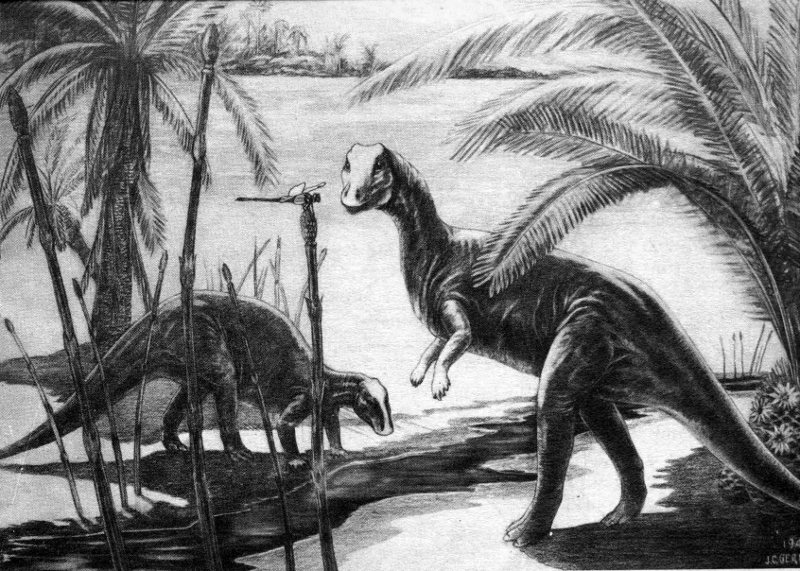
Camptosaurus—AN ARNITHISCHIAN PLANT-EATER. (DRAWN BY J. G. GERMAN. COURTESY, AMERICAN MUSEUM OF NATURAL HISTORY.)
The concentration and burial of dinosaur bones is only the beginning of the fossil story. The combination of circumstances which operated here was a common one and yet fossil quarries are rare. Why? The bones have to be preserved and this seldom happens. The bones that are buried in one flood are frequently unearthed and scattered by the next. Those that are exposed to the weather usually disintegrate completely in a few years. The bones in the Dinosaur Quarry did not.
Sometime after they were buried, the organic minerals of the bones were more or less completely replaced by minerals of inorganic origin such as silica. No one knows exactly why or how this happened, but it did. Most geologists think this replacement process occurs when subsurface or ground water containing soluble and colloidal minerals dissolves a molecule of the bone and immediately replaces it with a new mineral. Roughly such a process is like removing red bricks from a house and substituting yellow. When the substitution is complete, the house still has the same dimensions but it is composed of different materials. The replacement was a faithful one, too, because microscopic structure of the original bone was faithfully reproduced by the replacing minerals.
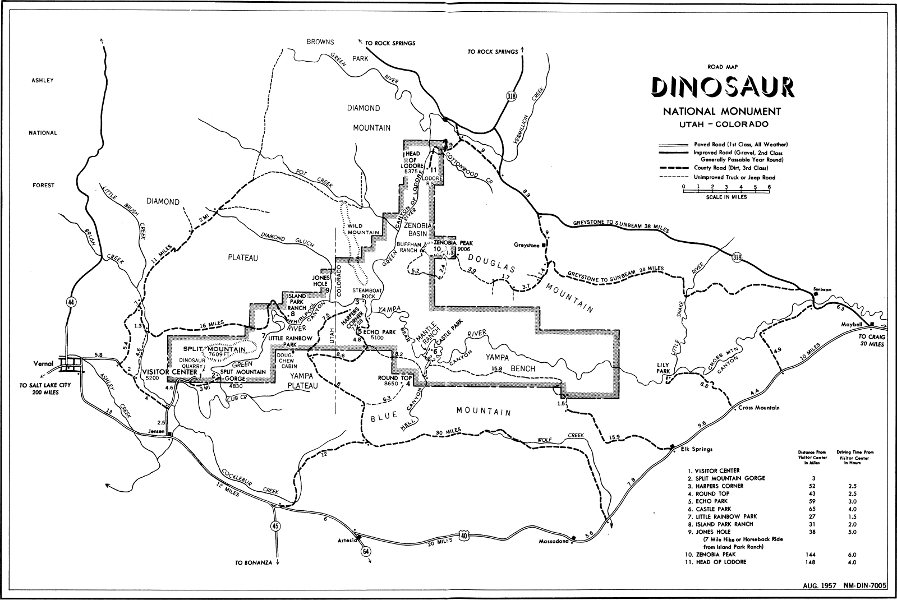
ROAD MAP
DINOSAUR
NATIONAL MONUMENT
UTAH - COLORADO
High-resolution Map
Following Morrison time, thousands of feet of younger sediments were deposited on the sandbar that contained the dinosaur bones. The whole sequence of sediments was compacted into rock and some bones were crushed and distorted.
After the sediments became rock and the bones had probably been replaced by stone (fossilized), this part of the world, which lay near or below sea level for millions of years, began to rise. Great forces acted upon the earth’s crust. These forces created faults, or fractures, in the rock crust along which movement occurred. And what had once been sea bottom was moved upward and became lofty mountains. This titanic change has been called the Laramide Revolution; it closed the Mesozoic Era with the formation of the Rocky Mountains.

Stegosaurus. AN ARMORED DINOSAUR OF THE JURASSIC PERIOD. (FROM A DRAWING BY CHARLES R. KNIGHT. COURTESY, AMERICAN MUSEUM OF NATURAL HISTORY.)
Although the effects of the Laramide Revolution were not as profound at Dinosaur as they were east of it, they were quite important. The rocks were lifted to form the southwest flank of Split Mountain—a small arch, or anticline, on the south side of the Uinta Mountains. This mountain building explains the pronounced southward tilt of the Dinosaur Ledge and other rock layers visible in the quarry area. As the land rose, streams flowed more rapidly, cutting deeper into the rocks and carrying away the debris. Gradually thousands of feet of this debris—shale, sandstone, and clay—were stripped away through erosion.
Finally all the material on top of the Morrison sandbar weathered away. Some 140 million years after burial the fossil bones were exposed by the agent that had buried them so long ago—running water! All that remained was for them to be found, and that was the luckiest chance of all. Just suppose they had been uncovered a million years ago—only a second in geologic time. No one would have been present to discover them, and through the years they could well have crumbled into dust and been blown away.
At Dinosaur National Monument only Morrison rocks of the upper Jurassic Period contain the fossil bones of dinosaurs. After Morrison time, the Cretaceous seas invaded this area. More than 5,000 feet of sandstone, shale, and mudstone were formed from sediments deposited in these seas.
Elsewhere in North America and the rest of the world, the diversity and numbers of dinosaurs actually increased. Entirely new groups evolved and achieved success in the battle for survival. The climax of reptile development seems to have come near the end of Cretaceous time in the Mesozoic Era. As the dinosaurs ruled the continents, so did other strange reptiles dominate the seas. Had you been able to see this ancient world, you would surely have been convinced that the dinosaurs and other reptiles would rule forever.
But it was not to be. The dinosaur hordes were wiped out and the reptiles reduced to the position of relative insignificance they occupy today. Such a profound and sudden change in the evolutionary trend of life must have had a cause, and scientists have sought it. Several theories have been proposed to explain extinction of dinosaurs, and they are most interesting.
At the end of Cretaceous time, some of our great mountain ranges were formed. It was a time of earthquakes and of volcanoes that belched forth clouds of ash and rivers of molten rock. Some people 26 would say these catastrophic events killed all the dinosaurs. The scientist shakes his head. If these events killed dinosaurs, why not the other animals that lived with the dinosaurs. And what of those parts of the world that had no volcanoes, what killed dinosaurs there?
Changes in environments, the drainage of lakes and swamps as young mountains rose, changes in vegetation as new plants replaced old, and sudden shifts of climate occurred. These conditions could explain local extinction, but there were places where these changes did not occur and yet all dinosaurs in all places died.
A one-time favorite theory suggested that increasing numbers of small mammals ate dinosaur eggs, but there were many mammals eating dinosaur eggs during all of Cretaceous time and the dinosaur hordes increased. Many more mammals during succeeding ages have not killed off the turtles, snakes, lizards, and crocodiles that lay eggs and exist in great numbers today.
Some disease or combination of plagues may have swept the dinosaurs into extinction. If so, no evidence has been found to date that confirms or denies. However, most paleontologists do not accept this theory.
These are some of the theories that have been advanced to explain the sudden extinction of dinosaurs throughout the world. Each theory will explain the death of some dinosaurs in some places but attempts to apply any of them, or combinations of them, to worldwide extinction have failed.
This dinosaur story is like a mystery thriller with the last pages torn out. A most important part is missing. That is true and the paleontologist knows it. He also knows the riddle will probably never be solved. He might point out, however, that no one has successfully explained the extinction of the passenger pigeon which occurred quite recently, nor do we know why some other species of wildlife are on the brink of extinction today. The paleontologist is not the only one who must say, “I don’t know.”
No one knows how long the old bones had been weathering out of the hills of what is now Dinosaur National Monument before the first man saw them. Curious Indians, wandering between the upturned ridges of Mesozoic rocks, picked up fragments and carried them off to their camps where they are now found among the arrow points, ax heads, and corn-grinding stones. In 1776, the Spaniard, Father Escalante, passed within sight of today’s dinosaur quarry, not dreaming 27 of the antiquity hidden there. Maj. John Wesley Powell, on his second voyage down the Green River in 1871, recorded the presence of “reptilian remains” in the area, but wrote nothing more about them. Sheepherders, cattlemen, and hunters observed them and were impressed in proportion to their understanding. But, through all the years, the nature of the bones remained a mystery.
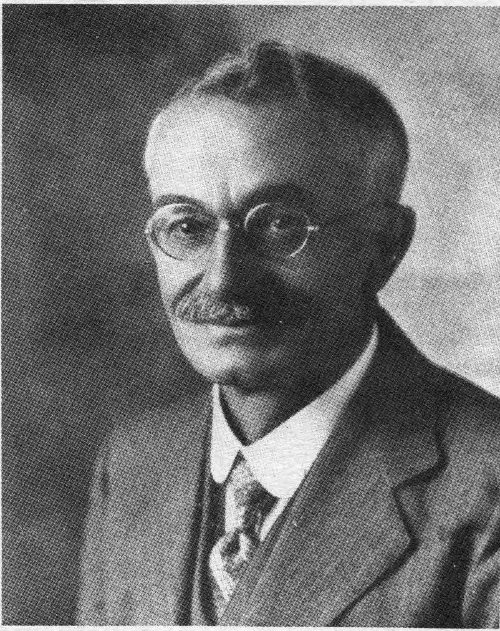
EARL DOUGLASS, DISCOVERER OF THE DINOSAUR QUARRY.
Then, in 1893, this mystery was solved. O. A. Peterson, a scientist from the American Museum of Natural History, while conducting field work in the Uinta Basin to the south of the present monument boundaries, discovered bones out-cropping from a recognized fossil-bearing stratum. The stratum was the 140,000,000 year-old Morrison formation. The bones? Peterson reported them as the remains of dinosaurs.
That report was to have an important influence, 15 years later, in directing a fellow paleontologist from the Carnegie Museum in Pittsburgh to investigate the area. Earl Douglass was the paleontologist’s name. In 1908, he and W. J. Holland, Director of the Carnegie Museum, found themselves in the region of Peterson’s discovery, searching for dinosaur remains. They extended their search to the north and thence along the Morrison hogback that flanks Split Mountain. Bone was found—not much, but enough to bring Douglass back the following summer and in company with George Goodrich, a local resident, to pursue the hunt.
The hunt came to a triumphant climax on August 17, 1909, when—to quote from Douglass’s diary—“At last in the top of the ledge where the softer overlying beds form a divide ... I saw eight of the tail bones of a Brontosaurus {Apatosaurus} in exact position.”
This was the beginning—the beginning of the celebrated dinosaur quarry which was to yield such a multitude and variety of ancient forms to science, and eventually lead to the establishment of Dinosaur National Monument.
Douglass proceeded to dig into the solid rock along those original eight tail bones and found other parts of the skeleton. In time, the almost complete frame of the Apatosaurus was exposed. The skull was missing and parts of the limb bones, but this was to be expected, as fossil vertebrates are rarely preserved in their entirety. What was not expected were the remains of a smaller dinosaur comingled with those of its huge contemporary.
Douglass was elated. This was more than a “one strike”! How much more, only further digging would tell. Sensing a large-scale operation, he informed the Carnegie Museum of his prospects and readied things with the intensity of a man at the gate of destiny. From the neighboring ranches he recruited men, horses, and equipment. He sent for his wife and child. He constructed a road to the discovery site, built a five-room cabin out of logs and lumber, converted a sheepherder’s camp wagon into an office, selected ground for future planting, bought a cow. A forge was set up. Tools were purchased.
Back at the museum, Andrew Carnegie, himself, evinced interest. He had always wanted something “as big as a barn” for his institution. A special annual field fund of $5,000 was added to the regular budget to carry on the work.
Within a year, Douglass and his men had run a cut over a hundred feet long in the hard sandstone, digging down along the almost perpendicular slant of the rock. At the base of this, rails were laid and small mine carts introduced to haul away the cuttings from the rapidly developing quarry.
New specimens appeared: A small plant-eating dinosaur known as Dryosaurus; an armored form called Stegosaurus; and another large creature like the Apatosaurus. Best of all, the Apatosaurus No. 1 was well on its way out of the rock and would soon be ready to ship to the Carnegie Museum in Pittsburgh.

“... I SAW EIGHT OF THE TAIL BONES OF A Brontosaurus IN EXACT POSITION.” (FROM DOUGLASS’ DIARY, 1909. SHOWN IN PHOTO IS DOUGLASS’ ASSISTANT, ELDER GOODRICH.)
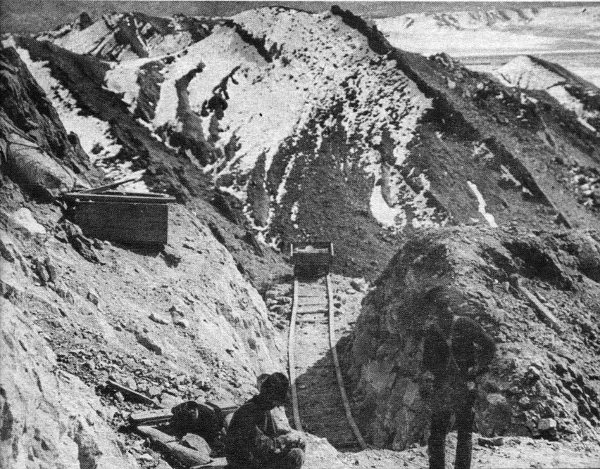
THE FIRST CUT IN THE QUARRY, AS IT LOOKED IN 1910. (COURTESY, A. S. COGGESHALL.)
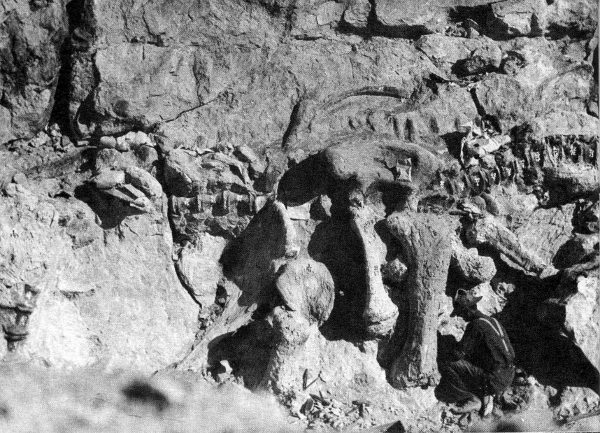
SAMPLE VIEW OF DINOSAUR REMAINS AS THEY WERE UNCOVERED IN THE QUARRY. THIGH BONE NEAR MAN. (COURTESY, A. S. COGGESHALL.)
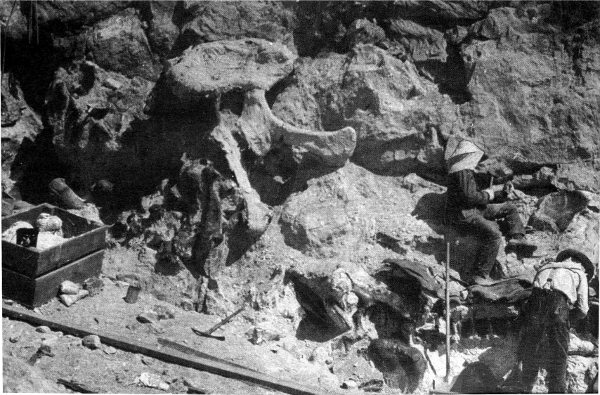
QUARRY OPERATIONS. SAURISCHIAN PLASTERED PELVIS UPPER CENTER. (COURTESY, A. S. COGGESHALL.)
In 1913, after 3 years of laboratory work in the Carnegie Museum the big Apatosaurus was on its feet in the Hall of Vertebrate Paleontology—1 of the 4 mounted specimens of this genus in the country and the most perfect of all. Prepared and erected by Arthur S. Coggeshall and his associates, it measures 71½ feet long and stands 15 feet tall at the arch of the back.
As the excavating progressed it was not long before the diggings became what is known to the profession as a “general quarry.” Dinosaurs of “all kinds and sizes” were showing up. Other quarries of this type had been developed in previous years in the Morrison formation at Como Bluff, Wyo., and Canon City, Colo., but they contained nothing like the variety of forms found here. Moreover, these at the monument were better preserved and the skeletons more intact.
The remains most frequently encountered in the diggings were those of sauropods—the huge plant-feeding dinosaurs with long tapering extremities that lumbered about on four pillar-like legs. Camarasaurus and the larger Apatosaurus were typical members of this group, and their numerous bones show them as being common animals of their time.
More common were the Diplodoci, of the exaggerated neck and even longer whiplash tail. This genus distinguished itself by producing not only the largest amount of skeletal material from the quarry, but also the largest number of skulls—those rarest of fossils. One skull was found in exact position with the neck bones, which settled all doubts as to the details of this animal’s head piece. The longest Diplodocus to come from the monument extended 75½ feet.
Contrast this with the diminutive Laosaurus, a 2½-foot biped which ranks as the smallest dinosaur yet taken from the deposit. This tiny creature had hollow limb bones and was one of the agile, quick-running types. Only one was found. When discovered, Douglass thought it a “baby” dinosaur, but study proved it to be a full-grown specimen. The condition of the skeleton reflected considerable agitation before and after burial. It lay on its back, the limbs distended. The tail was gone and the skull crushed.
In many respects, the most interesting dinosaur found was the sauropod, Barosaurus. It was an extremely long-necked form, some of the individual cervical vertebrae measuring 3 feet in length. Two specimens were excavated.
The flesh-eaters, as might be expected from their scarcity in other localities, made but a small showing. Two specimens of Antrodemus were unearthed. Thirty feet long, this animal was the ranking predator of its day, although hardly comparable to the towering Tyrannosaurus that entered upon the earthly scene at a later age.
Stegosaurus remains—so abundant that Douglass grew tired of them—added a bizarre note. An armored form, it was equipped with a frill of bony plates that extended the length of the back and terminated 32 in a pair of sharp spines. Its chief claim to fame rests in its supposed two sets of “brains,” one a motor-control center situated in the hip region, and the other in the usual place.
Everywhere they dug, the excavators found fresh material—a vast jumble of bones so concentrated and intermingled as to make it difficult to distinguish one specimen from another. Douglass was amazed. Obviously, it was not with animals of a single area that he was dealing, but of an entire region. He was dealing with a dinosaur fauna. He was also perplexed. How did so many different types happen to occur in one small locality?
Slowly, as Douglass’s acquaintance with the deposit grew, the answer came. It was, he reasoned, the work of a river. The sandstones were ancient sediments. In their structure and composition lay the story of swift swirling currents. The coarse granular texture told of fast water; the crossbedding, of shifting channels; the grouping of the bones into clusters, of eddies.
It all added up to an old delta deposit at the mouth of a river, a region of bars where the carcasses of dinosaurs brought down stream accumulated. Settling, the great hulks became buried as they sank into the receptive sand. A number of carcasses multiplied ... and slowly, as flesh and ligament decayed, the bones became mingled, eventually to petrify and remain preserved through the ages.
At the quarry, excavating continued summer and winter. The methods employed were those that paleontologists had used for decades. There was no compressed air, no labor-saving devices. The work was done by hand. The crew, which seldom exceeded four men at any one time, became veterans in the art of fossil extraction. The bone was brittle; the encasing sandstone, hard. It required toil, patient direction, and a knowledge of anatomy.
Judiciously placed charges of giant powder shattered the overburden. Hand drills, wedge-and-feather, and crowbar worked the rock away, until the bone layer was encountered. The slow attrition by hammer and chisel accomplished the final delicate separation of the remains from the enclosing matrix. Team-and-scraper and small handcarts removed the rubble that swiftly accumulated in the cut. As the bones were chiseled from the quarry face in large blocks of rock, they were encased in strips of burlap dipped in flour paste. (Later, plaster of Paris supplanted the flour paste.) Then they were lowered by rope onto a mule-drawn skid and “snaked” down the trail into the gulch to await boxing.
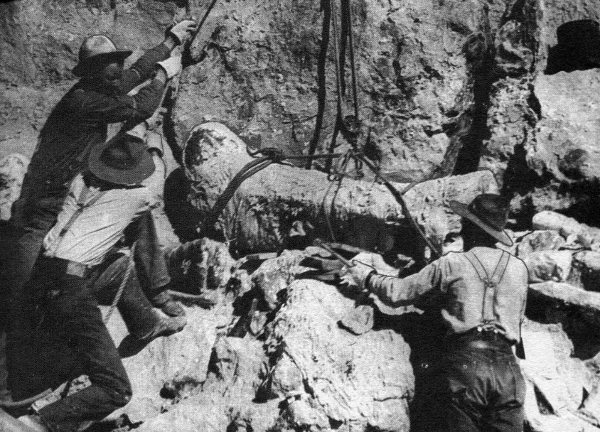
REMOVING A LARGE THIGH BONE FROM THE QUARRY WALL DURING THE CARNEGIE MUSEUM OPERATIONS. (COURTESY, A. S. COGGESHALL.)
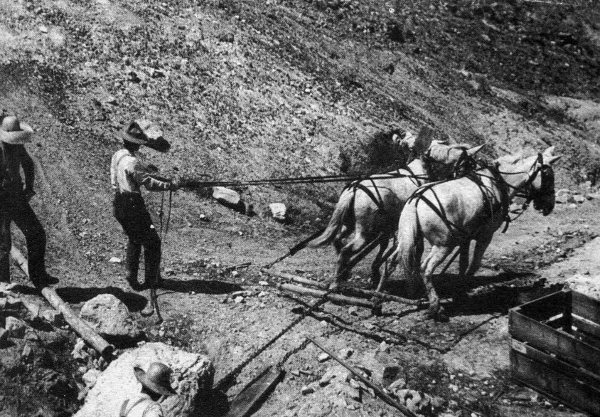
PLASTERED SPECIMEN REMOVED FROM THE QUARRY DURING THE CARNEGIE MUSEUM OPERATIONS. (COURTESY, A. S. COGGESHALL.)
Transporting the fossils from quarry to railhead was a major undertaking. It required wagon trains—4-horse teams hauling high-wheeled freight wagons over 60 miles of rutted roads to Dragon, Utah. There the precious goods were loaded onto boxcars of the now abandoned narrow gauge Uintah Railway, later to be transhipped to the standard gauge Denver & Rio Grande line at Mack, Colo.
Specimens continued to show in record abundance, most of them duplicating the earlier finds of Diplodocus and Stegosaurus. But there were new forms, too. One of them was a Camptosaurus, the first to be found at the quarry. It was a modified biped of plant-eating habits, a little more than 10 feet long, with its skull and part of the tail missing.
By 1921 the deposit had been worked to a length of 400 feet east and west, and to a depth of about 60 feet. Rock was being stripped from the quarry face at the rate of approximately 20,000 cubic feet annually, and the chisels of Douglass and his men had penetrated to the richest bone-bearing zone.
In the following year they uncovered one of the most perfect skeletons of a dinosaur ever exhumed. It was a small sauropod named, Camarasaurus lentus. When found, its 17-foot vertebral column was practically intact, except for a few tail segments. The skull was in place, and the limbs in their approximate positions.
It was an important find scientifically. The position of the limbs gave clear evidence of the manner in which these animals carried themselves. The articulation between the thigh bone and the pelvis showed conclusively that sauropods walked with their legs more-or-less vertical to the body and not with the bowed-out crawling posture habitual to lizards, as many scientists had supposed. The skull was the finest known for this genus. It was complete even to the sclerotic ring—a complex of bony plates which surrounded the living eye and protected it.
As exhibit material it was without rival. It was mounted as found, lying on its side, the bones fixed in death in the matrix in which they had been preserved—a fitting climax to the 13 consecutive years that had seen an unknown sandstone ridge in Utah become Dinosaur National Monument.
In those 13 years the Carnegie Museum had taken from the quarry parts of 300 dinosaur specimens, 2 dozen of which were mountable skeletons. Ten different species were represented. It was the best collection of Middle Mesozoic monsters in the world.
In the years that immediately followed, the still-rich “dig” was worked by two other organizations—the Smithsonian Institution and the University of Utah.
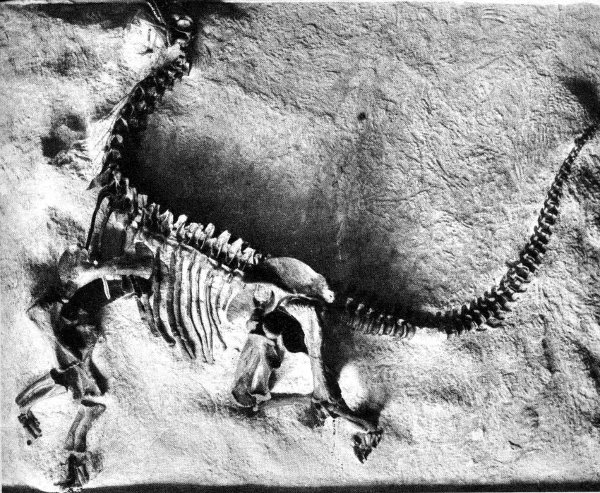
Camarasaurus SKELETON—THE MOST PERFECT REMOVED FROM THE QUARRY. (COURTESY, CARNEGIE MUSEUM.)
But finally the museums had reaped their harvest. The fruits of the harvest had gone to enrich many of their finest displays. However, still buried in the untouched part of the wall were the remains of still more dinosaurs. All that was needed was to reveal them. The 67° tilt of the rock made it a perfect exhibit face. Strip off the overlying layers, expose the skeletons, and relief them in place. This had been Douglass’s idea as far back as 1915, when he recorded it in his diary.
But Douglass was not the only one to realize the necessity of preserving this unique fossil record of the dinosaurs for people of today and the future to see on the spot. Officials of the Carnegie Museum realized the extraordinary nature of the deposits and their contribution to our knowledge of the past; and they were not long in taking 36 steps to protect the dinosaur quarry. To preserve it for science, they sought to lay claim to it as a mineral property. But their claim was disallowed by the U. S. Department of the Interior, because fossil bones could not be classed as a mineral within the meaning of the mining laws.
The museum pressed its case, this time with results—but not what they expected. The outcome was not the establishment of a mere mineral claim, but of a national monument. Under the provisions of the Antiquities Act, to safeguard and preserve objects and areas of significant scientific or historic interest, the dinosaur quarry and 80 acres of surrounding land were declared a national monument on October 4, 1915. Less than a year later it was included in the newly created National Park System.
Several things contributed notably to this action to protect the quarry. They were: the exceptional preservation of the bones; the number, variety and completeness of the skeletons; the relative abundance of skulls, consisting of 8 or more in a complete state, and about an equal number of incomplete ones; and the finding of the first complete tails.
In 1923, knowing that the quarry was protected, and that the scientific collection of the fossil bones for museum exhibit was at an end, Earl Douglass turned again to the idea of making a perfected exhibit of the fossils right where they lie. His letter to Dr. Walcott, secretary of the Smithsonian Institution, reads, in part, “I hope that the Government, for the benefit of science and the people, will uncover a large area, leave the bones and skeletons in relief and house them in. It would make one of the most astounding and instructive sights imaginable.”
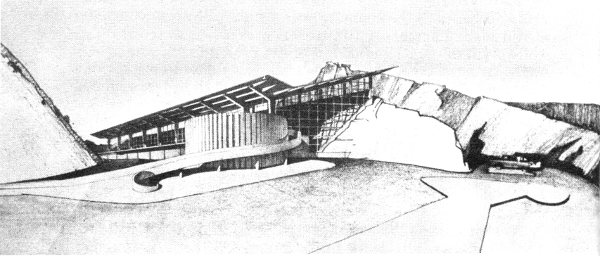
ARCHITECT’S DRAWING OF VISITOR CENTER AT QUARRY SITE.
This is precisely what the Government had in mind and, through the agency of the National Park Service, intended to accomplish. Plans for an in-place exhibit were drawn up. But many years were to elapse before the plans passed from blueprint into reality.
In the meantime, the quarry entered the second phase of its existence, a dormant period from a scientific viewpoint, but one in which the forces of the future gathered ground.
During the 1930’s the monument served as a transient camp. A. C. Boyle was installed as resident geologist and custodian for the Park Service. Under his guidance a program for the general development of the area was carried on, financed largely by WPA funds. This entailed, among other things, the deepening and widening of the quarry cut, and the construction of buildings later to accommodate the monument staff and exhibits.
The American Museum of Natural History became interested in the development at this time and, through its curator of fossil reptiles, Barnum Brown, sought to initiate a joint effort with the Park Service for exhibiting the quarry remains.
It was not until September 1953 that the years of Park Service planning bore fruit, and the work of developing an in-place exhibit for the monument was begun. Many factors operated to spring the project into being, not the least of which was the active interest and wholehearted support of Horace M. Albright, a former Director of the Service.
Theodore E. White, formerly with the Smithsonian Institution and with Harvard University, was placed in immediate charge, under the supervision of Jess H. Lombard, the superintendent of the National Monument. His task, and that of his associates, was to expose the remaining specimens in the quarry wall and work them out in bas-relief.
A shelter had been built over the working space and power tools were introduced for the first time. Using compressed air, the rock was scaled off with jackhammers and “paving-breakers,” until most of the overburden had been removed. Subsequent probing into the bone layer was done with smaller chipping hammers, mallet, and chisel. This operation continued through 1954 and 1955 as, slowly and carefully, the extent of the skeletal material was determined. It comprised parts of several large dinosaurs, sufficient in quantity to justify the next step—the construction of a building to enclose the quarry face.
Erection of this unusual structure, the first of its design to be attempted, commenced in 1957 and it was opened to the public in the following year. Now, as one of the many development projects in its 38 MISSION 66 program, the National Park Service has resumed the delicate work of uncovering this corner of the ancient world and preserving it in-place for all time.
If you stand at the overlook, you will see the Green River, Split Mountain, and a rolling plain to the south that stretches to a hazy line of mountains. To many, it is an unfamiliar land that lies strangely subdued beneath a blazing sun and an intensely blue sky.
That blue sky is the key to the kinds of plants and animals that live in this part of the monument. They live most of their lives under blue sky, and, even when clouds do form over the mountains and drift across the lowlands, the results are disappointing. A high wind, dust and sand, a few drops of rain, and the storm is over.
The climatic conditions under which local plants and animals live are conditions of extremes. On summer days the temperatures may rise above 100°, although the nights are usually cool. During the winter, temperatures may skid to 30° below zero or more. It is not uncommon for the thermometer to remain below zero for weeks on end. But the most influential climatic factor is water—and there is little of it. The total yearly precipitation is a little less than 8 inches! It is interesting then to find such a wide variety of plants and animals that not only survive but flourish under such rigorous conditions.
The methods used by plants in adapting to arid conditions are interesting and varied. The wide-spreading, shallow root system and thick stem of the cactus enhance collection and storage of water. These strange plants are quite plump with stored water in the spring when the snows melt, but they gradually lose this plumpness during the dry summer, and by autumn many seem lifeless.
Other plants conserve their water by minimizing the loss through their leaves. This may be done in a number of ways. The leaves of the spiny greasewood are covered with a waxy substance that inhibits water loss while the leaves of the sagebrush are covered with hairs or fuzz that serve the same function. The leaves of the juniper are scale-like and really don’t look like leaves at all. The most direct method of preventing water loss through leaves is to drop the leaves themselves, and this method is used to a greater or lesser degree by many desert plants. The serviceberry is a good example of this method. In late summer it looks dead, and yet the following spring finds it robed in green and covered with flowers.
In contrast to the frugal habits of the plants just described, the cottonwoods seem lavish indeed. Usually big trees, they spread a canopy of green in whose shade rest birds and animals alike. Have you ever 39 rested under a cottonwood? If so, you will remember it as being cool even on the hottest days. Part of the coolness was due to the hundreds of gallons of water which are transpired through the leaves each day. Because cottonwoods require so much water, they usually grow along streams or near springs. Frequently they are seen along dry ravines where their thirsty roots tap the subsurface drainage that lies hidden below. Like the other plants however, when the supply of water becomes inadequate they shed their leaves and wait for the next spring. Fast growing, usually of large size, and wasteful of water where water is dear, the cottonwood seldom lives two hundred years while the twisted juniper on the dry, rocky ledge frequently lives as much as five hundred.
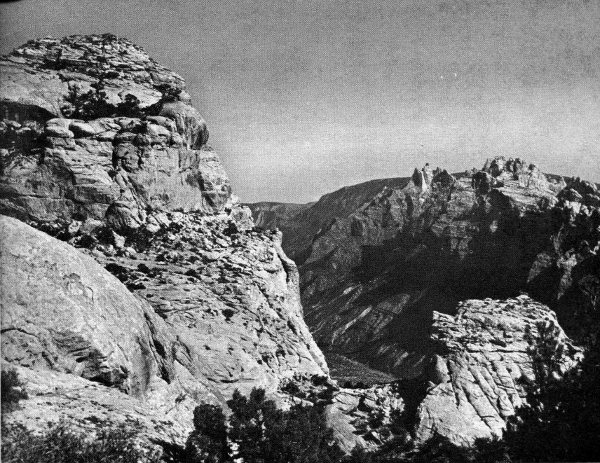
SPLIT MOUNTAIN GORGE.
Inconspicuous through most of the year are the flowering plants. Some of these are annuals—plants that grow from seeds, mature, bloom, produce seeds, and die in the span of a few short weeks. When the snows melt and the sun warms the earth, the seeds that survived the winter germinate. The usually barren hillsides produce spots of green that soon spread to form patches as more and more plants mature. Lupine and locoweed are purple and heliotrope splashes 40 color along the roads, while the fragrant, white, evening-primrose dots the sandy hillside. Scarlet gilia and Indian paintbrush add a touch of red to the scene, and orange is provided by the mallow.
April, May, and early June provide the best flower show as spring rains supplement the moisture from melted snow. Their races won, their seeds produced, the annuals wither and fade away as the temperatures rise. By the first of July little remains of the splendid show.
Two plants do brighten the desert scene in August and September. Most common is the rabbitbrush, a plant that grows almost everywhere. It is rather inconspicuous except in late summer when its brilliant yellow blossoms turn the whole shrub golden. The other is the bee plant of which there are two species: one has yellow blossoms, and the other has purple. These tall plants grow along washes, stream courses, roads, and irrigation ditches. Their delicate blossoms are always surrounded by insects drawn by the nectar the flowers produce in great quantities.
These, then, are a few of the typical plants. Each has adjusted its needs to those limiting factors—winter cold, summer heat, and aridity. A great number of plants grow on the monument that have not been mentioned here, but they are like the typical plants and have similar ways of meeting the problems of survival.
Many people who profess an interest in nature admit they cannot get very excited about plants. Such disinterest may result in minimizing the importance of plants in the general scheme of nature. That would be a major error. The plants of the world are the foundation upon which other forms of life are dependent. They alone are able to utilize the minerals in the soil and convert carbon dioxide and water to carbohydrates. Because of these abilities, the parade of life has been able to advance only when the plants advance. In the present as in the past, the kinds and abundance of plants set definite limits as to the species and numbers of animals an area may support. Thus, if man changes the plants of an area he will surely change the animals too, whether he realizes it or not.
If you drive to the quarry in the heat of the day you will see only a few of the birds that live here. They don’t like to hunt their food during those hot hours. Frequently a turkey vulture sails majestically above the plains along the Green River. Sometimes so high he appears to be a speck, his telescopic eye searches the ground for the carrion upon which he feeds. Another bird that does not mind the heat is Say’s phoebe. He is usually found perched on a fence post, a wire, or a dead branch waiting for some insect to buzz by. A graceful, short flight, a pop of his beak, and then back to his perch to repeat the cycle again. As he sits motionless, his gray breast and darker gray head and back make him hard to see.
The time to watch birds is in the evening; as the sun sinks and the 41 air cools, they come forth. Small gray-brown rock wrens hop among the boulders near the visitor center. Robins scurry through the leaves in the stream course below the Dinosaur Quarry. Here too, western flycatchers and Audubon’s warblers search among the cottonwoods for insects. A flash of red and white is seen as a red-shafted flicker darts from its nest in the hollow trunk of a tree. The sky is filled with wheeling, twittering rough-winged swallows and white-throated swifts that descend from their nests on the cliffs to feed upon the gnats and other flying insects.
These are the birds that spend the spring and summer here. They raise their families and, young and old alike, depart in autumn when frost kills the insects upon which they feed. As they flee the cold of winter, they are joined by many other birds that make their summer homes at higher elevations or more northern latitudes. Ducks, geese, and swans join the hordes moving southward. So do the various shore birds, bluebirds, and hummingbirds.
But the sagebrush flats and brushy ravines are not left vacant by this wholesale migration, for as the summer residents move out the winter residents move in. The Oregon and gray-headed juncos spend the entire winter here. Great flocks of mountain bluebirds descend from the mountains and piñon jays make the hills resound with their screams. Canada geese and golden-eye ducks live on the Green River and remain until it freezes. The harsh croak of the raven is seldom heard in summer but often in winter.
Few birds live here in winter and summer—the golden and bald eagles, the red-tailed hawk, and the little sparrow hawk. Perhaps the most handsome year-round resident is the magpie with its long, iridescent tail, black and white body, and white patches on its wings. One other resident makes his presence known by his eerie cry on frosty, moonlit nights—the western horned owl. He hunts every night, summer and winter, but is seldom seen. Occasionally he is disturbed upon his daylight roost and as he skillfully dodges through the junipers, he makes a joke of the story that owls don’t see well in daylight.
The mammals that live in the vicinity of the Dinosaur Quarry are almost never seen. There are several reasons for this—almost all of them are nocturnal, are very shy, and most of them are small.
In spite of their retiring habits, they reveal their presence in a number of ways. Patches of bare earth under sagebrush and nearby sandy slopes are crisscrossed with tiny paths beaten into the dust by deer mice. Along the river bank, gnawed tree stumps, a few fresh chips, and perhaps a webbed footprint tell us beaver have been active during the night. The paired hind footprints of the kangaroo rat are common on the hillside. Freshly fallen snow records the preceding night’s activities in perfect detail.
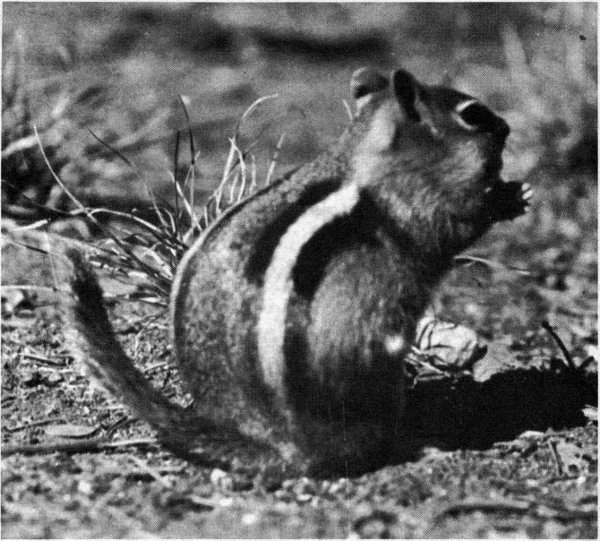
GOLDEN-MANTLED GROUND SQUIRREL
Were it not for the golden-mantled ground squirrels, our evidence of mammals would be mostly indirect. But these little fellows are very much in evidence all day long as they play around the visitor center and in the picnic areas. They are handsome too, with their alert black eyes, cinnamon neck and shoulders, and dark side patches with white stripes. Most people call these ground squirrels chipmunks because both are striped. Actually the two are easy to tell apart; the chipmunk’s stripes run to the tip of its nose, but those of the golden-mantled ground squirrel extend forward only to the shoulder region. Any small, striped mammal seen near the quarry is probably a ground squirrel, as chipmunks are rare here.
The water problem is an ever-present one for the mammals as well as the plants. At first this may seem strange with the Green River so close and several springs in the hills, but most of the smaller animals have very restricted ranges. A deer mouse, for example, seldom travels more than 100 feet from his home burrow in his entire lifetime. The kangaroo rat and the desert woodrat also have limited ranges although theirs are somewhat larger than those of deer mice. The majority of such animals must meet their water needs without springs and seeps. How do they do it?
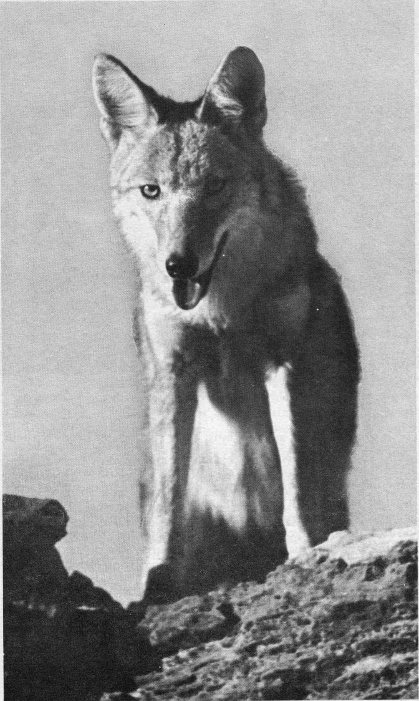
COYOTE. (COURTESY, U. S. FISH AND WILDLIFE SERVICE.)
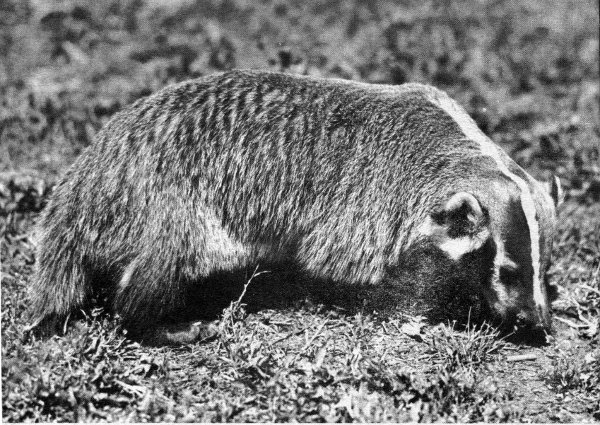
BADGER. (COURTESY, U. S. FISH AND WILDLIFE SERVICE.)
The food they eat contains some water. The green vegetation of springtime contains large amounts. Even air-dried foods such as seeds contain some. And these animals don’t need much. Through the thousands of years these little creatures have lived in arid lands, evolutionary processes have altered their bodies and life patterns to fit the conditions under which they must live. Surely one of the most useful and interesting of their abilities is that of utilizing metabolic water. Such water is obtained through oxidation of hydrogen contained in food and is a by-product of metabolism. Putting it another way, during the digestive process these animals are able to manufacture water from the chemical constituents of their food and the oxygen in their blood. The amount of water thus obtained is between 70 and 100 percent of the dry weight of the food eaten. Thus some desert animals are able to live a normal life span without ever taking a drink, and probably many of them do.
Carnivores such as the badger and the coyote get some of their 45 water from the animals they eat and may go for days without visiting a spring. But eventually they return to the river or a spring for a drink. This is no special effort as carnivores generally range for miles in search of prey.
Winter is a time of difficulty for most animals. Some of them like the ground squirrels hibernate and sleep the winter away, but the majority must rustle their “daily bread.” Winter storms drive the mule deer down from the high country. Mice tunnel through the snow in search of food. The white-tailed jackrabbit and the snowshoe hare change their coats from brown to white. In particularly hard winters the animals die in great numbers, first the weak and old, then the young, and sometimes even animals in prime condition fail to survive.
The reptiles that make their homes in the Quarry Area of Dinosaur National Monument are few in number. The rattlesnake is rare and seldom seen. The only common snake is the bull or gopher snake. This snake can appear very threatening as it swells its body and hisses loudly, but it is not poisonous. Gopher snakes climb well and are often seen in trees where they hunt for eggs and young birds.
Two lizards are commonly seen here during the summer. The side-blotched lizard is about 1¾ to 2⅛ inches long with a somewhat longer tail. These small brown lizards are frequently seen among the rocks near the parking and picnic areas. The name, side-blotched lizard, is taken from the black or bluish-black area behind the foreleg of the males. These lizards are also called brown utas.
The western whiptail is also a very common lizard. As its name suggests, it has a very long slender tail which it lashes from side to side as it runs. This lizard is easily distinguished from the side-blotched lizard by its larger size, longer more slender tail, and the presence of bars and spots of black upon its back. In late summer, junior-sized young whiptails appear, but their 3-inch total length is unimpressive compared to 8-inch adults. The young are quite handsome with pleasing body colors and bright-blue tails.
Often lizards are seen whose tails are missing. When the tail is pulled or injured it can be shed by its owner. The shed tail may wriggle for several minutes and attract the predator’s attention while the lizard escapes. The tailless lizard soon grows another one that is usually recognizable by its subdued or otherwise different color pattern. Sometimes the broken tail does not fall off so it and the new tail form a fork.
In summary then, we see that this apparently lifeless desert does support a wide variety of living things and a great number of individuals. Some of them, the plants and small animals, live here all year round while others, such as most birds, live here only part of the time. But whatever the length of stay, all living things must adapt themselves to existing conditions at the time of their stay. If they cannot adapt to static or changing conditions they must move or become extinct.
Some 60 million years have passed since the dinosaurs ruled the world. In that time mountains have risen, wasted away, and risen again. Glaciers have come and gone. Many species of plants and animals evolved and passed on to extinction. Every life form meets the test—adapt or die. That test is as real to the dusty lizard basking on the quarry face as it was to the dinosaurs whose bones you came to see.
| Dinosauria | (dy-noh-SAWR-eea) |
| Antrodemus | (an-troh-DEE-mus) |
| Apatosaurus | (apato-SAWR-us) |
| Ankylosaurus | (an-KEELOH-sawr-us) |
| Camptosaurus | (camp-toh-SAWR-us) |
| Stegosaurus | (steg-oh-SAWR-us) |
| Triceratops | (try-SER-a-tops) |
| Archosauria | (Ark-oh-SAWR-eea) |
| Mesozoic | (MEZ-oh-zoh-ic) |
| Triassic | (try-ASS-ic) |
| Jurassic | (jur-ASS-ic) |
| Cretaceous | (kre-TAY-shus) |
| Tyrannosaurus | (ty-ran-oh-SARH-us) |
| Saurischia | (sawr-ISS-key-a) |
| Ornithischia | (orni-THISS-key-a) |
| Diplodocus | (di-PLOD-icus) |
| Camarasaurus | (camara-SAWR-us) |
| Protiguanodon | (pro-teeg-GUAN-oh-don) |